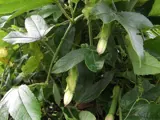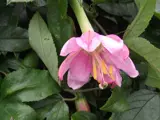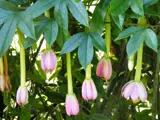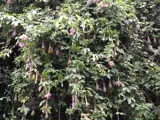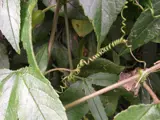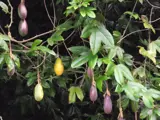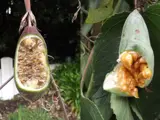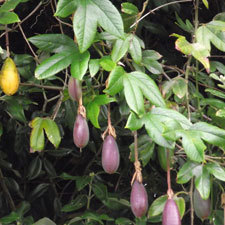 Banana
Banana
passionfruit
Common name: Banana passionfruit
Botanical name: Passiflora tarminiana, Passiflora tripartita
Management programme: Sustained control - Rule 5a applies
Native to South America where it is cultivated and sold for its edible fruit. Introduced to New Zealand as an ornamental garden plant, it was
considered naturalised around 1970.
Why is it a pest?
- It forms large masses, growing rapidly and smothering the forest canopy, preventing other plants from establishing.
- Seeds are dispersed by birds, pigs, and possums which can all carry them some distance.
Where is it found?
- Banana passionfruit can be found in hedges, orchards, exotic plantations, wasteland, gardens, and roadsides.
- Found throughout the Bay of Plenty.
What does it look like?
- Evergreen climbing vine up to 10m with long, densely haired stems with many spiralling tendrils.
- Leaves have three lobes, with longer middle lobe, serrated edges, and downy undersides.
- Pink hanging flowers with a central tube present year-round.
- Flowers (January to December) are followed by hanging, thin-skinned fruit which change from green to orange as they ripen. Fruit has a sweet edible orange pulp and dark red seeds.
What are the rules?
Sustained control
Sustained Control pests are well established in the region and preventing the spread is no longer a realistic objective. Management focuses on reducing general impacts of the pest. Landowners/occupiers are responsible for the control of these pest species on their land. Council may enforce control.
Under rule 5a of the RPMP landowners/occupiers must destroy this pest if required by a written direction from an authorised person unless a property specific pest management agreement has been agreed and signed between the occupier and the Council.
Criteria to meet Rule 5A include when the species is being actively managed by council, other agency and or community group, on an adjacent property. See the Regional Pest Management Plan 2020-2030 rules for Sustained control pests for more information.
How do you get rid of it?
Recommended:
- Hand pull roots up year around.
- Cut and paste stump with metsulfuron- methyl, triclopyr, Dicamba, or picloram.
CAUTION: When using any herbicide or pesticide, PLEASE READ THE LABEL THOROUGHLY to ensure that all instructions and directions for the purchase, use and storage of the product, are followed and adhered to.
Read more on pest control advice, information and regulations.
Images

